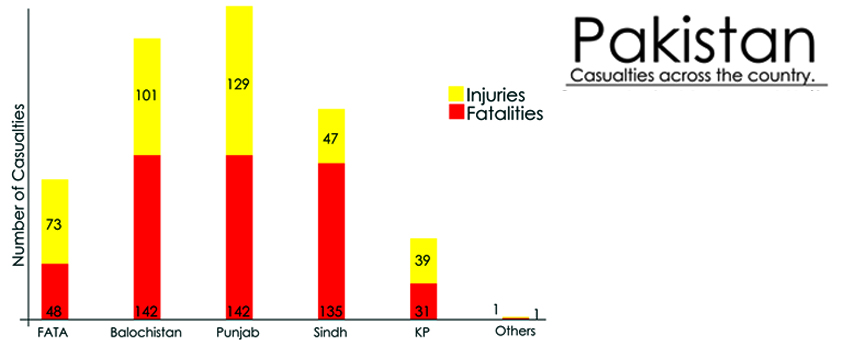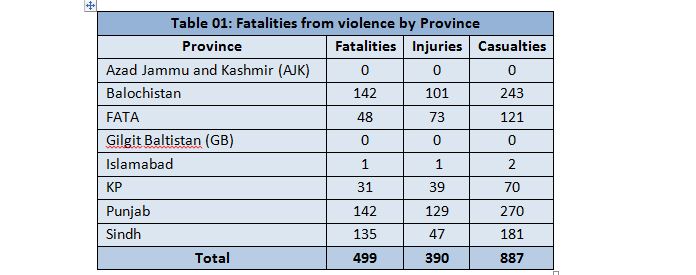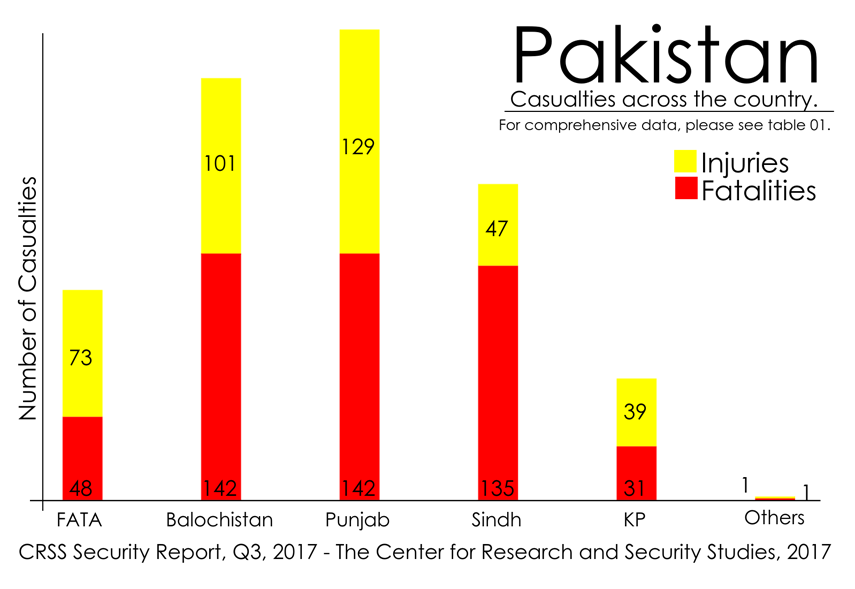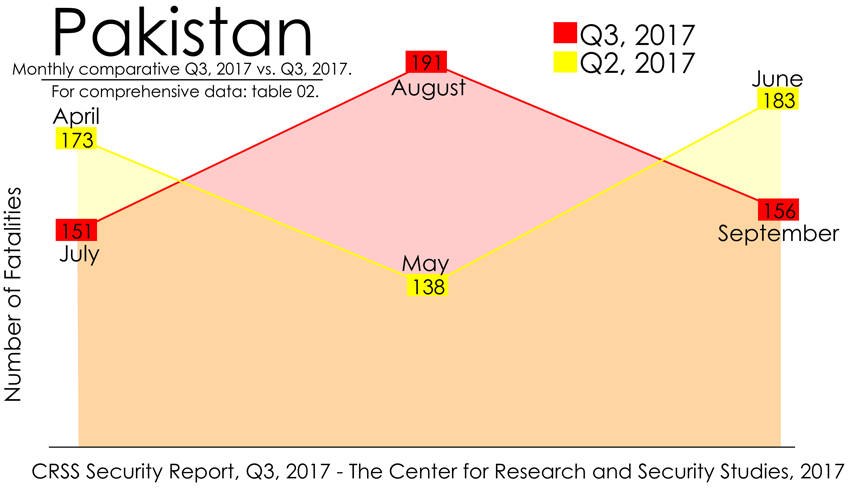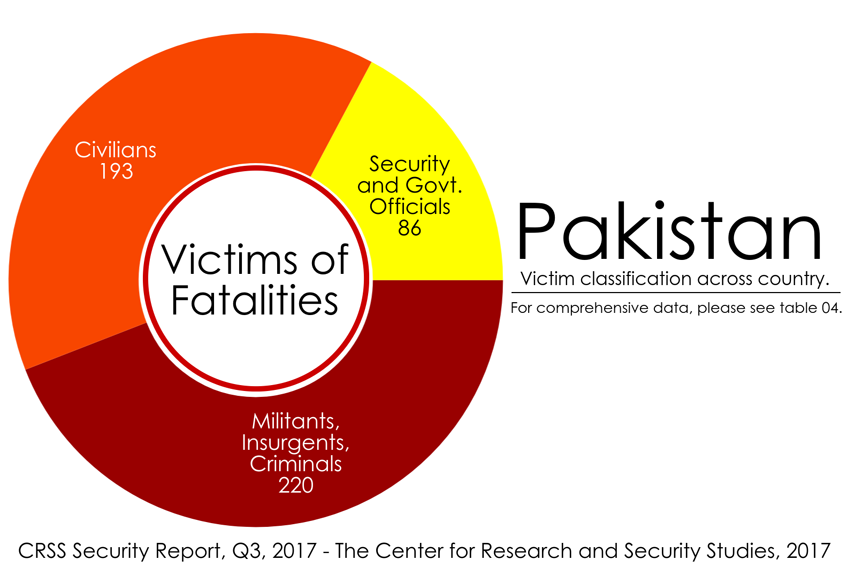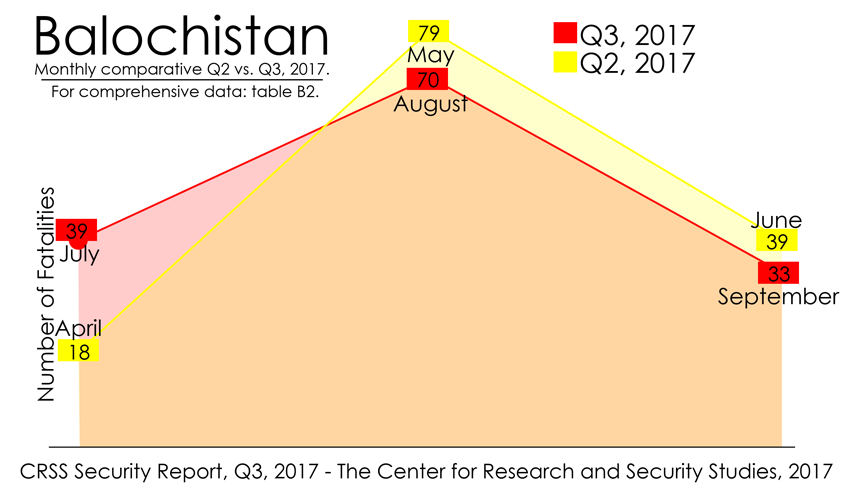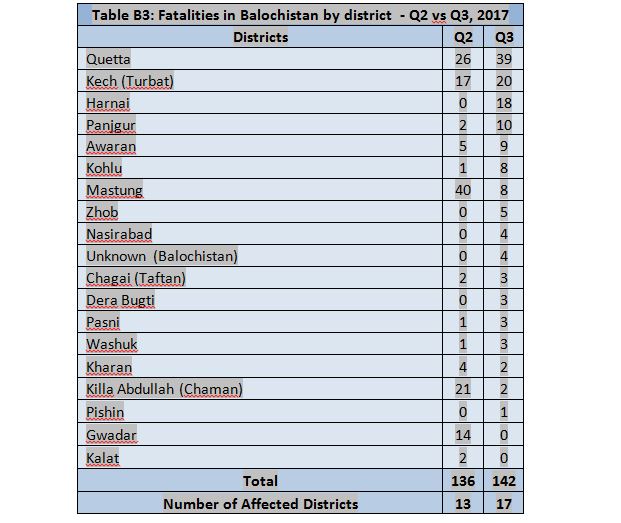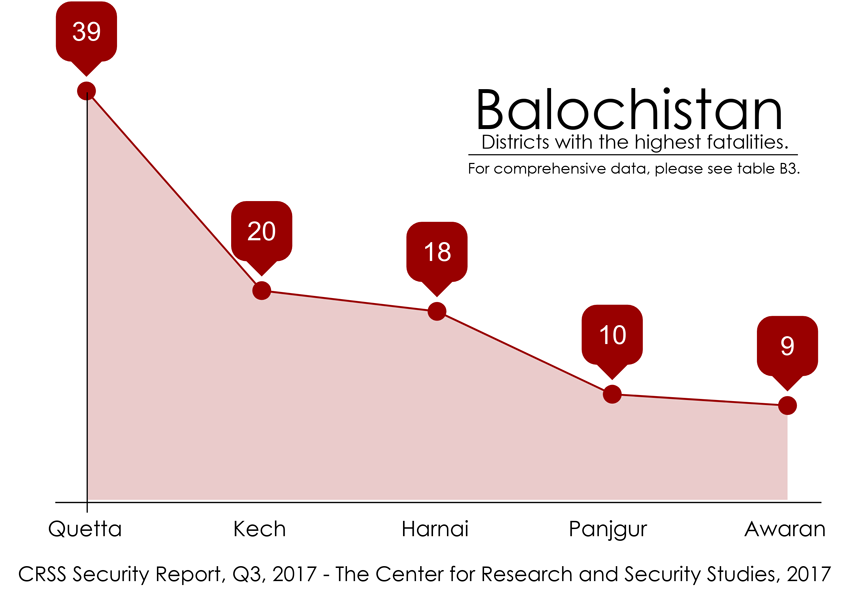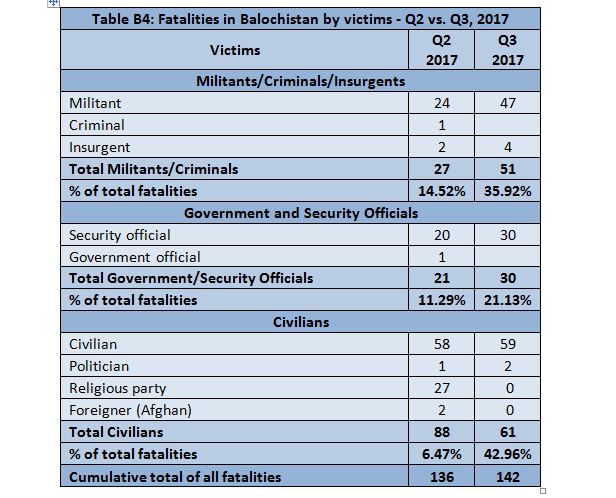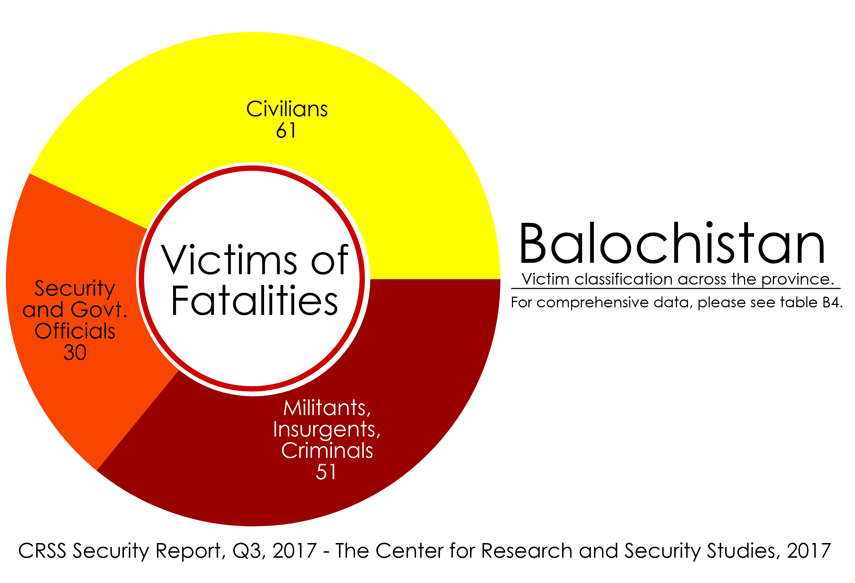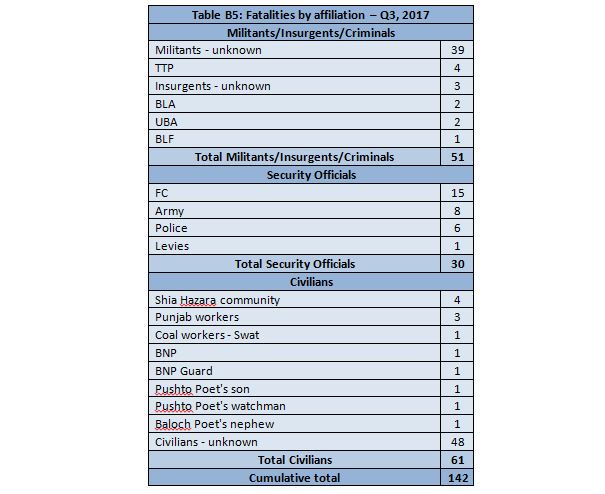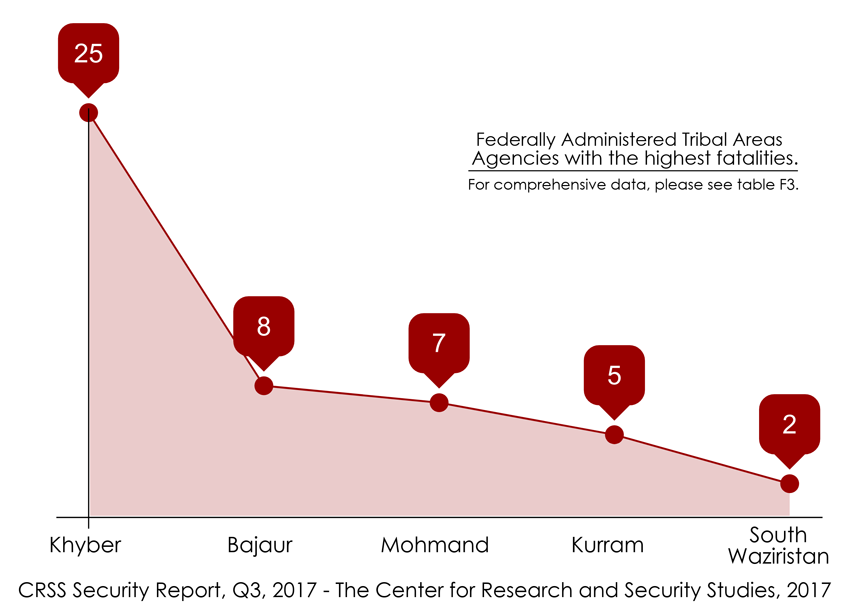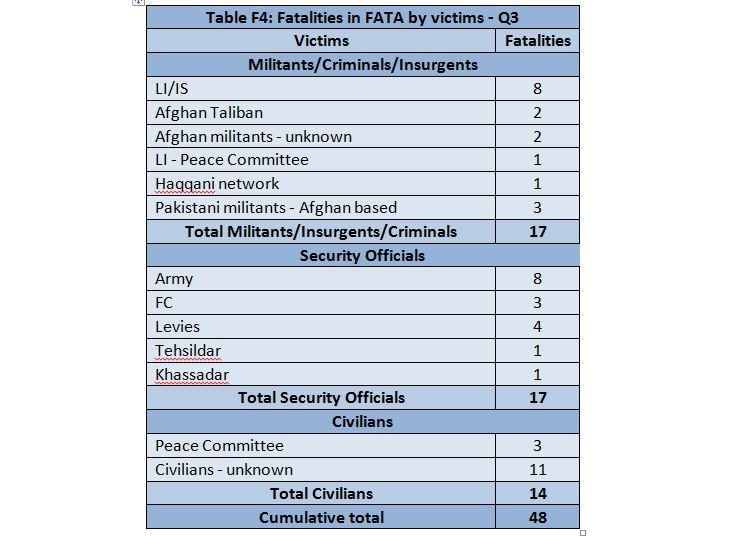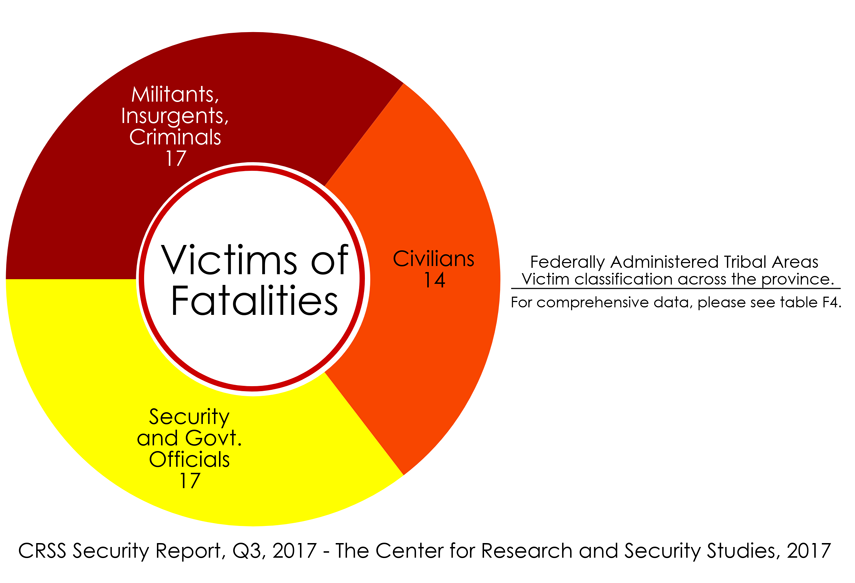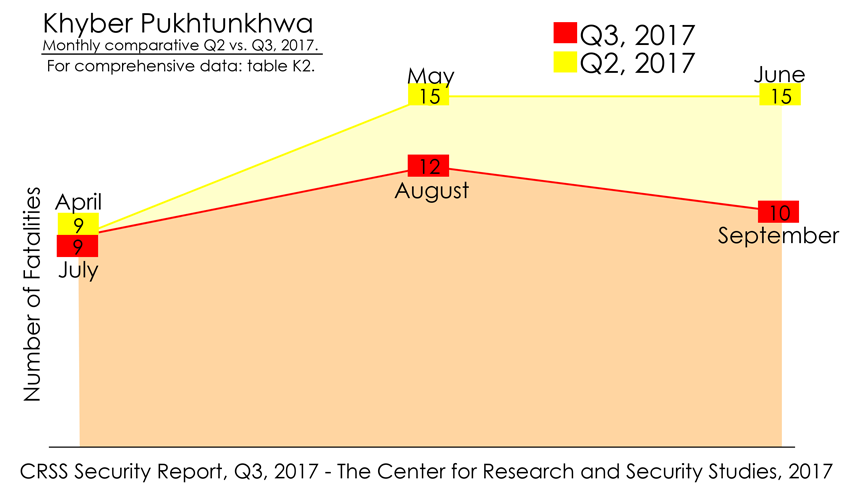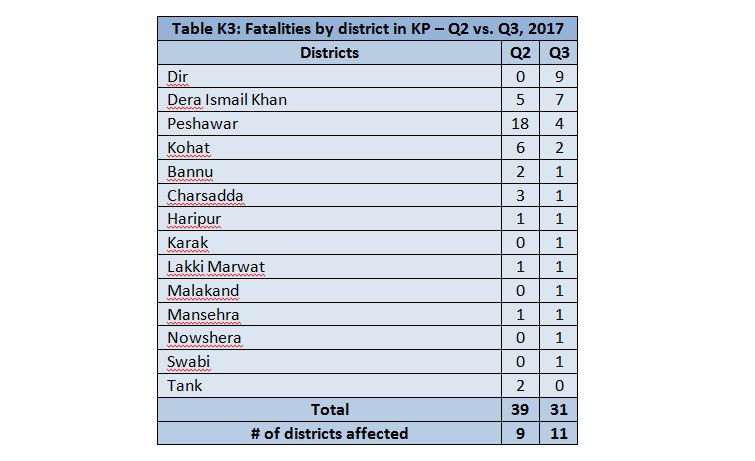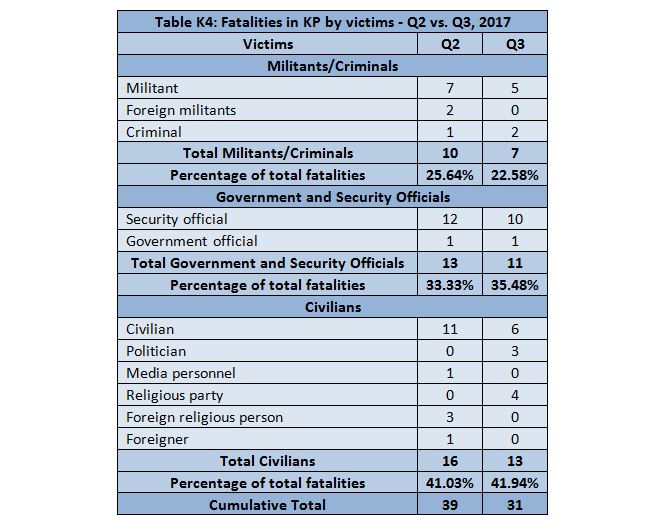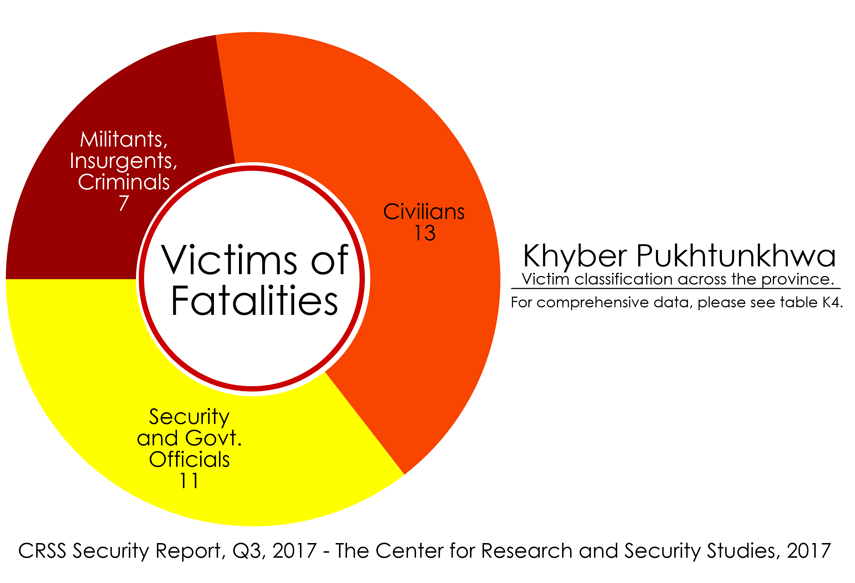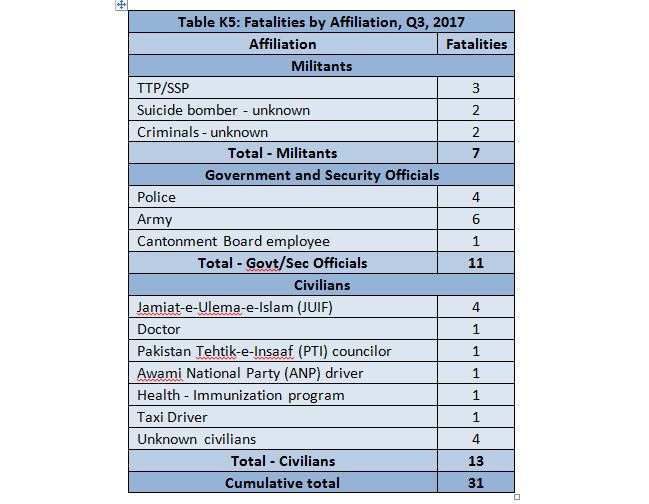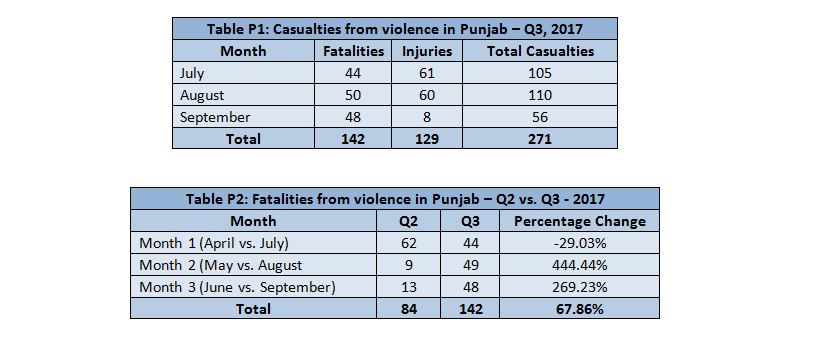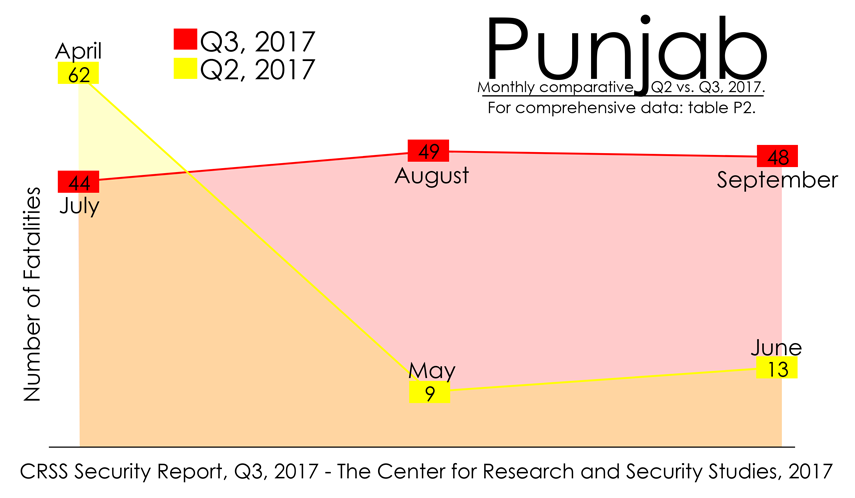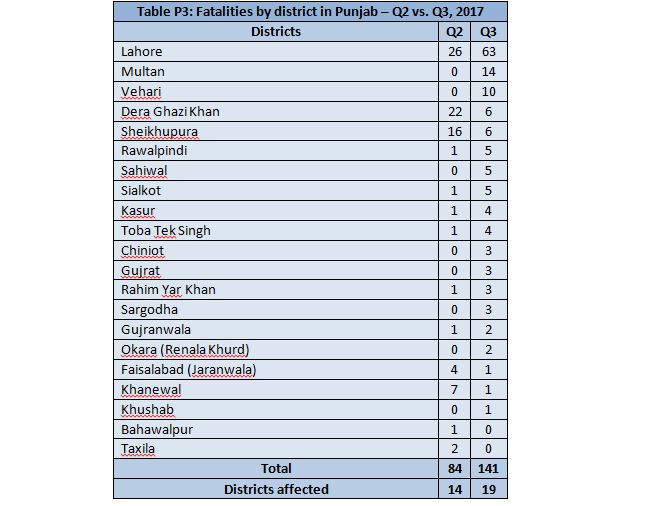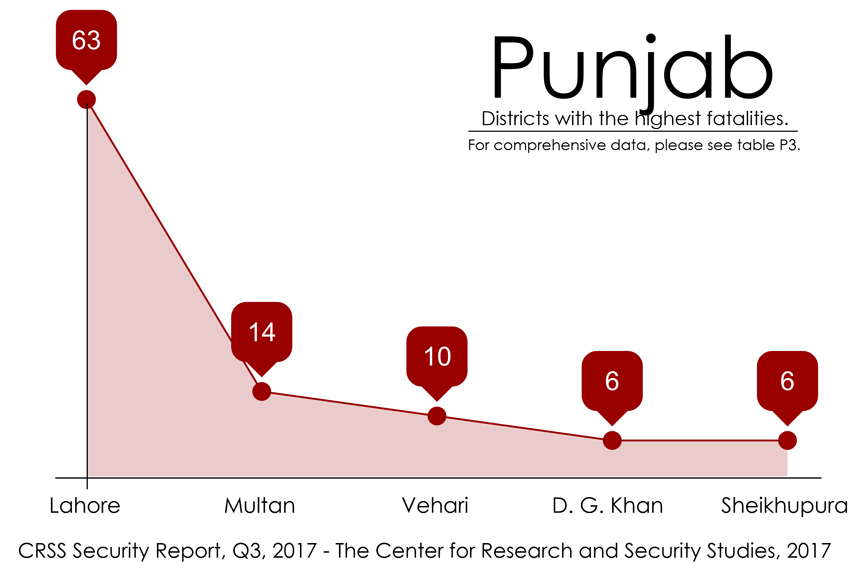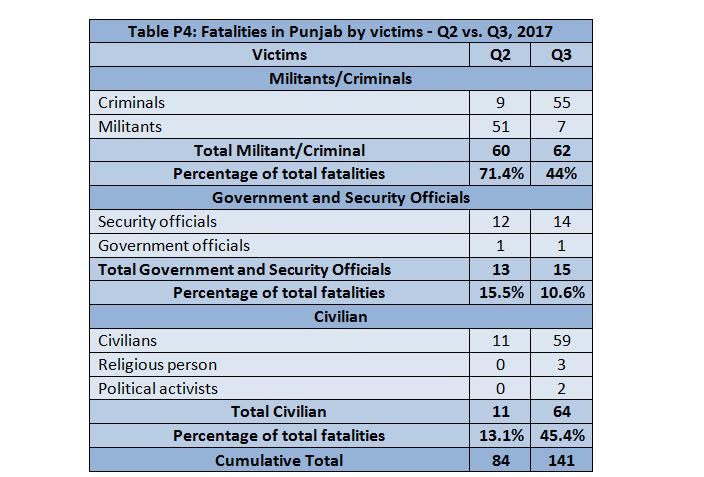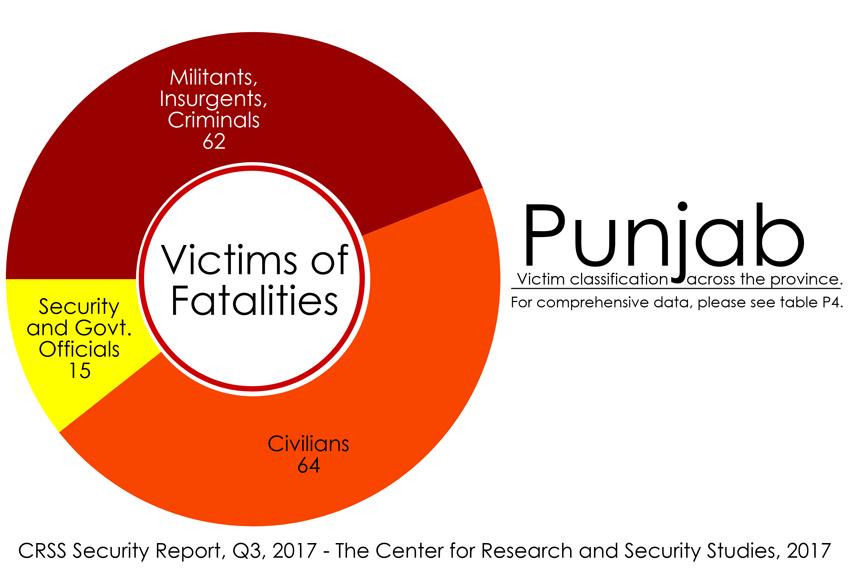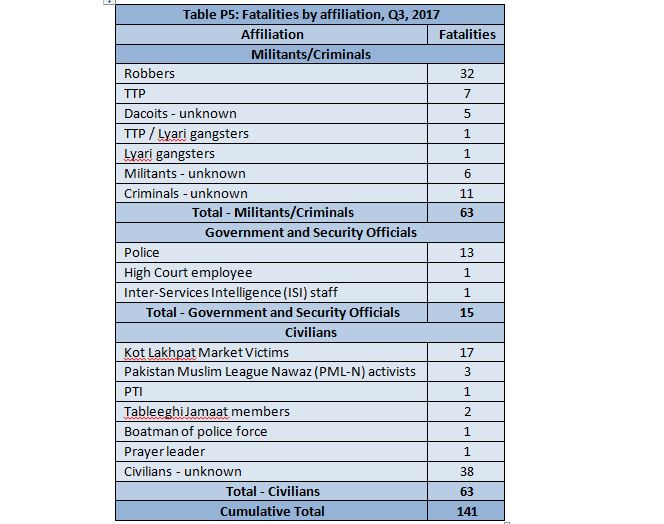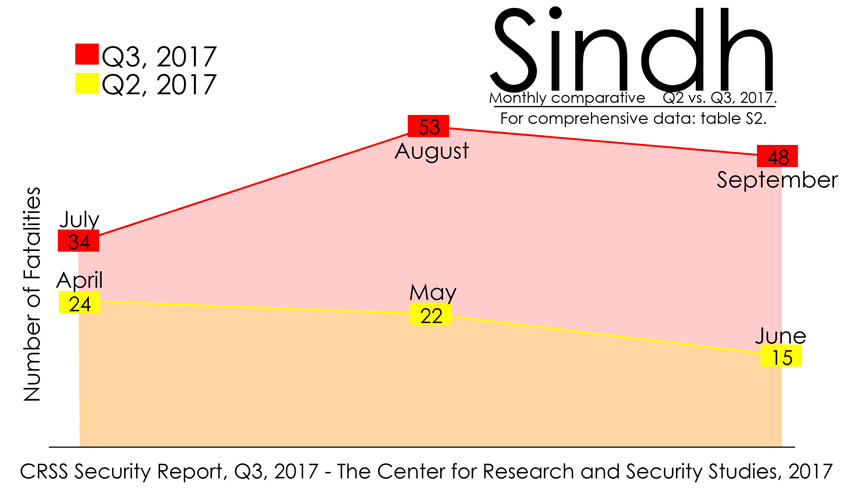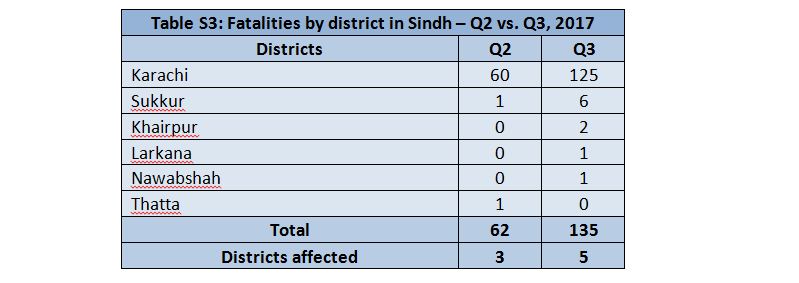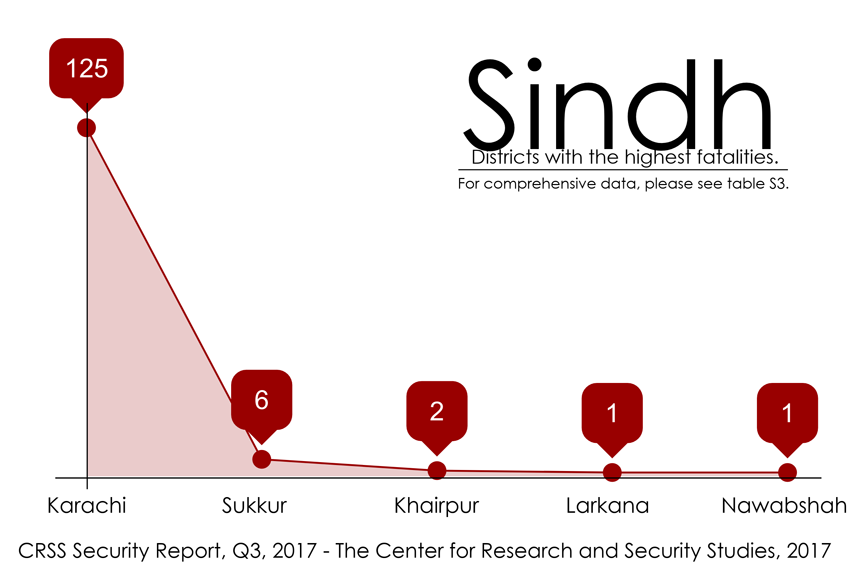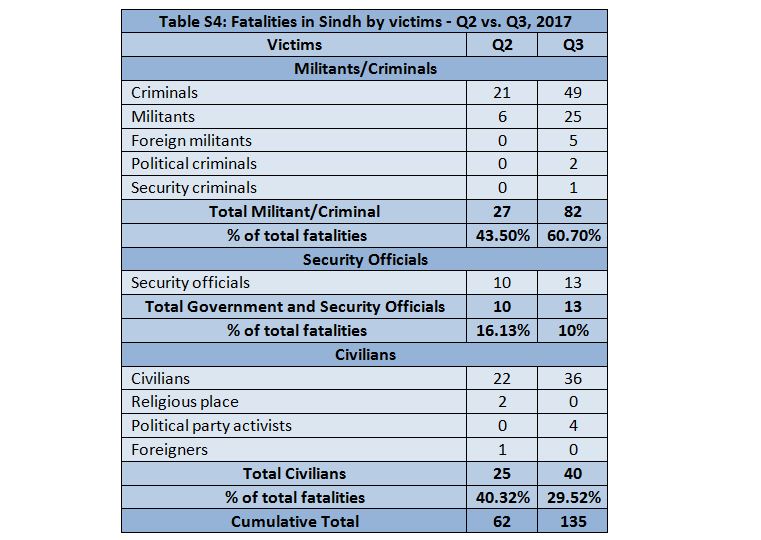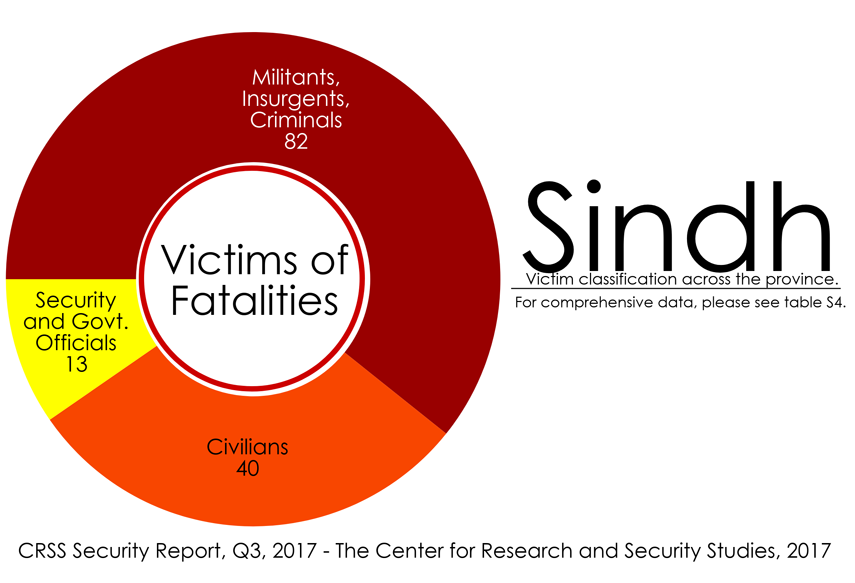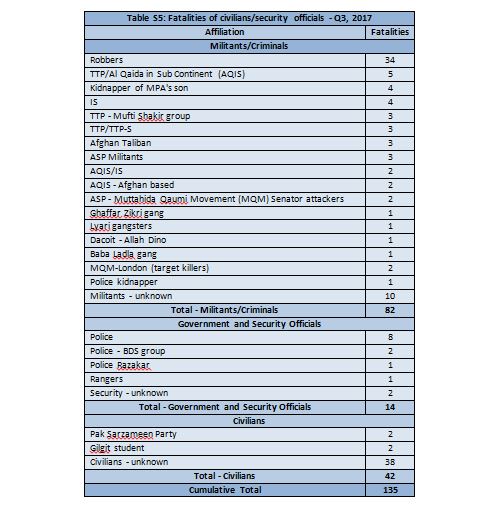Executive Summary:
Despite a visible decline in acts of terrorism, shifting loyalties within their cadres, and slowing military operations, militant groups adopted new tactics to sustain their presence and attempt spatial legitimacy. Infighting among terrorist outfits, emergence of new splinter groups and the drive for recruitment and retention seemed to drive the bulk of the militant agenda. They appear to have reverted to primarily targeting security personnel. The Tehreek-e-Taliban Pakistan (TTP) launched a female-centric publication, “Sunnat-i-Khaula”, following Daish’s (Islamic State – IS) footsteps in attempting to recruit educated females.
The significant decline in the number of fatalities from violence in KP and FATA during Q3 shows overall progress. The transportation of explosives and confiscation of armaments from FATA and other parts of the country show continued militant tenacity. After a string of successful military operations in the FATA regions, the provinces of Balochistan and Sindh appear to have become the main hubs for militant activity, with a pronounced focus on security forces.
Casualties from Violence in Pakistan:
During the third quarter of this year, 499 persons lost their lives and 388 were wounded in violence and counter-violence incidents in the country. Balochistan, Punjab, and Sindh, suffered the majority of fatalities while the Federally Administered Tribal Areas (FATA) and Khyber Pukhtunkhwa (KP) were the least affected by violence (table 01).
A comparative data of fatalities from violence in Q2 vs. Q3 shows that Punjab and Sindh have had a significant rise in fatalities, while FATA witnessed a sharp drop from 171 in Q2, to 48 in Q3. KP had a marginal drop in the number of fatalities. Overall, the increase in violence-related fatalities is negligible and does not signify any noticeable increase in overall violence across the country.
The fatalities from counter-violence operations by security agencies increased two-fold in Q3 compared to Q2. The number of persons gunned down increased by over 32%, nearly half of which were victims of robberies. In the last three months, 54 persons died in robberies, nearly equal to all robbery-related deaths in 2016.
Improvised Explosive Devices (IED) and landmines caused 39 fatalities in Q3, compared to 3 in Q2. However, suicide attacks and bomb explosions left 58 persons dead this quarter compared to 105 in previous quarter. Nearly twice as many dead bodies were found this quarter when compared to last quarter. In attempts to defuse bombs two policemen and two civilians also lost their lives.
The loss of civilian life dropped to 39% (193) from 52% (293) in last quarter. Security and government personnel also witnessed a marginal drop in the percentage of total fatalities (21% to 17%) but the overall number of their fatalities was higher than the previous quarter (58 in Q2, vs. 83 in Q3). During Q1 and Q2, 65 security persons succumbed to attacks. In Q3 this number is at 83.

At least 309 persons were wounded from these attacks which is 80% of the total number of injuries in this period (table 01 above). Militant and criminal injuries went up by 17% during this quarter.
Regional Breakdown
Balochistan:
142 persons were killed, and another 101 wounded in Balochistan during Q3, 2017 (table B1).
Comparative data shows that the number of fatalities for Q3 was slightly higher than Q2 (table B2). In contrast, the neighboring regions of KP and FATA both recorded a drop in violence.
At the district level, District Harnai observed a sudden upsurge. Quetta, Kech, Panjgur, and Awaran districts reported high casualty counts. In all other districts fatalities from violence remained significantly lower than these districts (table B3).
Nearly twice as many militants and insurgents lost their lives in Balochistan during Q3, when compared to Q2. There was also an increase in the casualties of the security personnel. There was a sizeable drop in civilian casualties (88 to 61) this quarter (table B4).
Most of the victims of violence and counter-violence in Balochistan remained unidentified. For those identified in the press, four eliminated militants were from the Tehrik-e-Taliban Pakistan (TTP), two from Balochistan Liberation Army (BLA), two from United Balochistan Army (UBA) and one from Balochistan Liberation Front (BLF). Among security personnel, the Frontier Corps (FC) had the highest casualties followed by the Army, Police, and Levies. Only 12 of 61 civilians were identified.
In two incidents of violence, ethnic communities of KP and Punjab were affected. The Shia Hazara community was also targeted. Two persons belonging to Balochistan National Party (BNP) and three affiliated with literary families of Balochistan also lost their lives (table B5).
TTP claimed one suicide attack in the province in Q3, 2017, via a new splinter group called Majlis-e-Abrar. BLA claimed an IED explosion in Harnai that killed eight security personnel. Please see table B6 for additional details.
BLA also gained notoriety when they displayed anti-Pakistani posters in Geneva, Switzerland triggering Raza Rabbani, Senate Chairman, to ask the Ambassador of Switzerland to leave Pakistan. The Pakistan Foreign Office stated that BLA’s campaign had become more ‘vicious’ after Indian Prime Minister Modi publicly acknowledged India’s role in Balochistan.
Federally Administered Tribal Areas
FATA observed the second lowest casualty count in the country, bested by KP. 48 fatalities and 73 injuries were reported in the region (table F1).
In Q3, FATA witnessed a 72% decline in fatalities, which makes it the least violent quarter this year (table F2).
Khyber Agency had the highest fatalities from violence during this quarter followed by Bajaur and Mohmand (table F3). Terrorism and military operations resulted in most of the fatalities. The military operation in Khyber Agency ended August 21, 2017 after seizing control of the strategically located heights in the area. Yet, militants remained active, killing 16 persons in FATA between August 23 and September 30, 2017.
Of the 48 killed, 26 were victims of terror attacks (17 security/government officials, 9 civilians). The remaining 17 were militants affiliated with banned outfits including Lashkar-e-Islami (LI), Daish (Islamic State – IS), Afghan Taliban, the Haqqani Network, and Afghan-based Pakistani militants (table F4).
Khyber Pukhtunkhwa (KP)
KP suffered 70 casualties from violence in Q3 (31 fatalities and 39 injuries), the lowest among all provinces and FATA (table K1).
This is also the lowest number of casualties reported from KP this year (table K2), a 10% drop from Q2, and a more than 80% drop from Q1, 2017.
Another significant improvement observed in KP was the unprecedented reduction in violence in the provincial capital of Peshawar (table K3). All other provincial capitals topped their respective regions in terms of the number of casualties from violence. The primary contributing factors for this improvement are better policing and the ongoing security operations in the neighboring FATA region. Dir and Dera Ismail Khan Districts were most affected by violence (table K3).
Civilian and security personnel’s fatalities accounted for 77% of the total number of victims (table K4). Militants accounted for the rest.
Of the seven militants/criminals, three were affiliated with TTP and Sipah Sahaba Pakistan (SSP). Affiliations of the other four were unknown. Among the security personnel, Pakistan Army and civilian police had the highest casualties. Of the 13 civilian fatalities, 6 had associations with religious or political parties (table K5).
TTP claimed two fatalities this quarter; the remaining attacks and fatalities were unclaimed (table K6).
Punjab
In Punjab, 271 casualties were tallied (142 fatalities and 129 injuries) during Q3. Average monthly fatalities were around 47 (table P1), which represents a nearly 70% increase in violence related fatalities (table P2).
Lahore, Multan, and Vehari Districts were most affected, while Dera Ghazi Khan, Sheikhupura, Sialkot, Sahiwal, and Rawalpindi Districts reported 5-6 violence-related fatalities (table P3).
Civilian casualties increased more than fourfold, while militant fatalities saw a nearly 30% decline. Security/government official figures also declined by a small percentage (table P4).
Outlaws (robbers and dacoits) were the highest casualty group among militants/criminals in Q3 (table P5). Militants associated with TTP were also eliminated in Gujrat and Lahore Districts. Eleven unknown criminals were killed in provincial security operations. In the security/government official category, the most affected group was civilian police (table P5). The highest civilian fatalities resulted from a suicide attack in Kot Lakhpat, Lahore (table P5), and was claimed by TTP’s newly formed Taliban Special Group (TSG). The other major claimant in Punjab is the Pat Gang, which seems to be gaining power and influence (table P6).
Sindh
A total of 135 fatalities and 47 injuries were reported in violence-related incidents in Sindh in Q3, 2017 (table S1).
Like Punjab, fatalities in Sindh also saw an increase (table S2).
Karachi District was the most violent, observing a more than two-fold increase in violence-related fatalities since Q2, 2017. Sukkur was the second most violent district, but the disparity between the two is significant – 125 in Karachi vs. 6 in Sukkur (table S3).
Despite this rise, the bulk of the fatalities belonged to the militant and criminal elements. A total of 82 (52%) outlaws were killed in Sindh in Q3 (table S4). This group included Afghan foreigners, political militants and even security officials. On the other hand, casualties of security personnel and civilians declined significantly (table S4).
In outlaws, robbers/dacoits had the highest casualties, followed by militants belonging to TTP, IS, and Ansarul Sharia Pakistan (ASP). Five Afghan militants were eliminated during security operations (table S5). Overall, Sindh boasted the largest number of criminals and militants eliminated this quarter.
Concerted attacks on law enforcement agencies resulted in the deaths of 11 policemen. Three policemen working for the Bomb Disposal Unit (BDU) were also killed in the line of duty. Among civilians, the majority were victims of robbery-related incidents or target killings.
Azad Jammu and Kashmir (AJK), Islamabad, and Gilgit Baltistan (GB)
In Islamabad, one person was killed and another injured. AJK and GB reported no casualties during Q3, 2017.
Sectarian Violence
Ten people were killed in sectarian violence in the country. Three belonged to the Shia Hazara community from Quetta (with a fourth in the vehicle which was fired upon), one was a Sunni prayer leader in Multan, two were members of the Sunni Tableegi Jamaat in Chiniot, and two were guards at an Imambargah in D. I. Khan. A Christian student was lynched by his classmates in Vehari.

